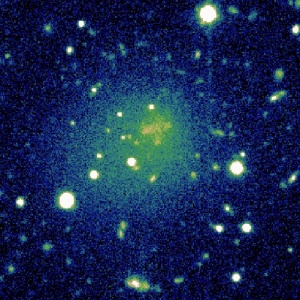W.M. Keck Observatory | 2019 Feb 26
A team of astronomers led by the University of California Observatories (UCO) have studied in great detail a galaxy so faint and in such pristine condition it has acted as a time capsule, sealed shortly after the dawn of our universe only to be opened by the newest technology at W. M. Keck Observatory.
DGSAT I, an Ultra-Diffuse Galaxy. Credit: UCO/Subaru
Using the Keck Cosmic Web Imager (KCWI), the team discovered a bizarre, solitary ultra-diffuse galaxy (UDG).
This transparent, ghost-like galaxy, named DGSAT I, contradicts the current theory on the formation of UDGs. All previously studied UDGs have been in galaxy clusters, which informed the basis for the theory that they were once “normal” galaxies, but with time have been blasted into a fluffy mess due to violent events within the cluster. ...
Because DGSAT I is a rare exception of a UDG found away from a cluster, it can provide a clearer window into the past. There has not been much activity around it that could taint its composition and evolution. In order to find out what caused this galaxy to be so sparse in starlight, the team used KCWI to map the composition of the galaxy. ...
DGSAT I surprised researchers with its chemical makeup. Today’s galaxies typically have more heavy elements in them, like iron and magnesium, compared to ancient galaxies born just after the Big Bang. But KCWI revealed that DGSAT I appears to be anemic; the galaxy’s iron content is remarkably low, as if it formed from a nearly pristine gas cloud that was unpolluted by the supernova death of previous stars. And yet DGSAT I’s magnesium levels are normal, consistent with what astronomers expect to find in modern galaxies. This is strange because both of these elements are released in supernova events; you typically don’t find one without the other. ...
Extreme Chemical Abundance Ratio Suggesting an Exotic Origin for an Ultradiffuse Galaxy ~ Ignacio Martín-Navarro et al
- Monthly Notices of the RAS 484(3):3425 (Apr 2019) 10.1093/mnras/stz252
arXiv.org > astro-ph > arXiv:1901.08068 > 23 Jan 2019
